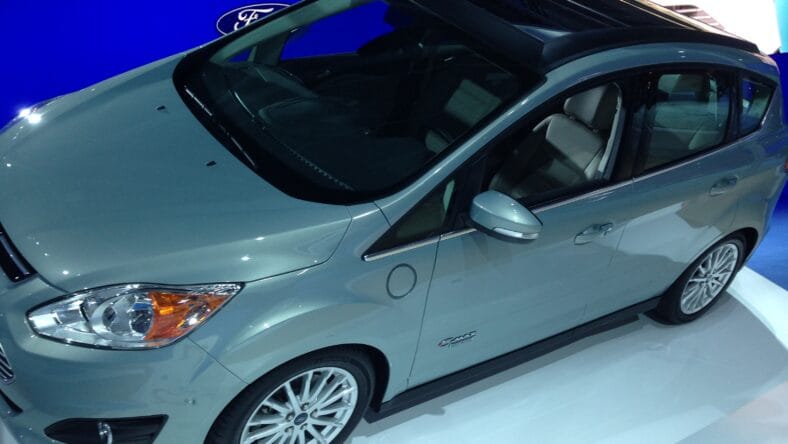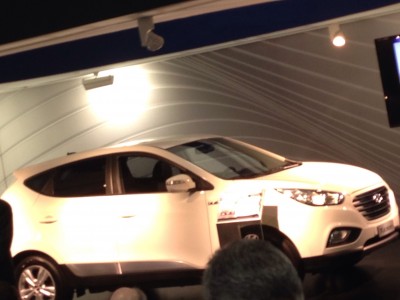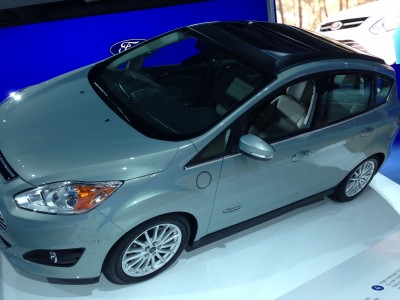Green Game Changers Took The Stage at 2014 Washington, DC Auto Show

Where Industry, Policy and Automotive Companies Come to Show You What They’re Up To
While you might not find luminaries like Kim Kardashian or Jay Leno at auto shows, you will mingle with public policy makers, auto manufacturers and industry forces focused on the future of the car industry. SBC Contributor Holly Reich talks about the greening of automotive industry and the green game changers on display sy the 2014 Washington DC Auto Show.
Nissan rented an Amtrak train car to deliver a group of journalists from Penn Station, NYC to Washington, D.C. to attend the 2014 DC Auto Show. It was an efficient way to arrive and consistent with Nissan’s push into the future of environmental changes. That objective encompasses Nissan’s NV200 vehicles (the taxicab of the future and NYC’s official taxicab) as well as some new initiatives the car maker is rolling out with FedEx: all electric delivery trucks set to roll out in test markets soon.
The Washington Auto Show
Known as the “Public Policy Show,” the Washington Auto Show is unique on the global industry circuit because of its proximity to the U.S. Congress, international diplomatic corps and federal agencies. Launched in 1921, the show’s purpose was for 20 Washington-area car dealers and distributors to sell the public on the horseless carriage! The show continued for 18 years in the National Guard D.C. Armory and went on hiatus twice – once for war and once due to poor economic conditions.
In early 1983, The Washington Auto Show found a new home at Washington Convention Center, which opened a modern, new building in 2003. The event has grown to cover almost eight acres – nearly four times the size of the Armory shows, with three times as many cars on display. Today, the Washington Auto Show, held in late January to coincide with Congress’ return from recess, capitalizes on the business of Washington. It has become one of the industry’s most prominent events that also include automotive shows in Detroit, Chicago, LA and New York.
The Green Game-Changers:
From Ford
Keynote speaker, Ford Motor Company Chief Operating Officer Mark Fields, announced new projects with Massachusetts Institute of Technology and Stanford University to research and create solutions to the technical challenges surrounding automated driving, the key to Ford’s Blueprint for Mobility. The blueprint outlines what transportation will look like in 2025 and beyond. With its automated Fusion Hybrid research vehicle, Ford is exploring potential solutions for the longer-term societal, legislative and technological issues posed by a future of fully automated driving.
$50 million in funding
U.S. Energy Secretary Ernest Moniz announced $50 million in funding for fuel-efficient vehicles. The investment includes backing for the Department of Energy’s EV Everywhere Grand Challenge, a program launched in March 2012 to make plug-in EV’s more affordable and convenient than gas-powered vehicles within the next ten years.
Moniz noted, “The new research and development funding announced today will help support our domestic automakers’ continued growth and make sure that the next generation of advanced technology vehicles are built right here in America.”
From Nissan
Eric Gottfried, Director Customer Quality for Nissan North America, said that Leaf sales have grown to 100,000.
In my interview with Gottfried he noted, “Almost every time we do research we find that the Leaf becomes the most used car in the house. In fact, Nissan has heard that people fight over the use of the Leaf because it’s the fun car to drive.”
“It’s innovation on a budget,” Gottfried added. “A fair number of our customers have two Leafs… it’s the kind of car that populates Facebook pages.”
FedEx Express and Nissan will also begin testing the Nissan e-NV200, a 100 percent electric compact cargo vehicle in Washington, D.C. as part of FedEx’s EarthSmart program. This effort aligns with Nissan’s “Blue Citizenship” initiative that focuses on increasing the number of vehicles that emit no greenhouse gases.
From Hyundai

Hyundai’s Tucson Fuel Cell available in California in Spring 2014; leases include fuel for the life of the lease
Mark your car calendars for Spring 2014 when the Tucson Fuel Cell will be available in California. Mike Moran, Hyundai Vice President of corporate and product planning, noted, “Hydrogen-powered fuel cell vehicles represent the next generation of zero-emission vehicle technology. The range and refueling speed of our Tucson Fuel Cell is superior to the range and charging limitations of competing battery electric vehicles.” As a bonus incentive, the price of the Tucson Fuel Cell, which is only available as a lease at $499 a month, includes refueling for the life of the lease. That means not only zero emissions, but zero fueling costs.
From Toyota
Toyota’s fuel cell concept, FCV, planned for 2015, is an electric drive vehicle with a range of 300 miles. The FCV mixes hydrogen and oxygen with emissions of …. H20! “Savvy consumers have been waiting to see an active change in fuel cell development, and we’re almost ready to hit the streets,” said Toyota’s Vice President of North American Business Strategy, Nihar Patel.
From Cadillac
Cadillac ELR received the Green Car Journal’s 2014 Green Car Technology Award. Cadillac Director of Emerging Markets Jim Vurpillat, said, “The Cadillac ELR “marries the fun-to-drive characteristics with electric propulsion and wrapped it in a beautiful package…We have a 112-year history, but it feels like a startup. We have momentum on our side.”
Green game changers continue to be the movers and shakers in the automotive industry, as Warren Brown, award winning Washington Post columnist, points out, “We are moving towards the autonomous car, which many people call the ‘driver-less’ or ‘self-driving’ car. The first manufacturer to produce a safe, reliable, retail-worthy version of such an automobile will win the race to control the future of the car. Nearly every major car manufacturer is involved in the contest.”
Brown explained that the objective is to maximize traffic safety. “Autonomous driving technology is designed to significantly reduce fatal mistakes (on the road). Examples include lane monitoring and blind-side detection systems, parking monitors and more. The aim is to produce more than gee-whiz automotive technology.”

